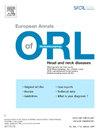各种扁桃体次全切除术的碳足迹。
IF 2.4
4区 医学
Q2 OTORHINOLARYNGOLOGY
European Annals of Otorhinolaryngology-Head and Neck Diseases
Pub Date : 2025-01-01
DOI:10.1016/j.anorl.2024.09.003
引用次数: 0
摘要
研究目的本研究旨在评估当前主要扁桃体次全切除术的温室气体排放量:一项回顾性研究于 2022 年在法国两所大学医院的儿科耳鼻喉科进行。目标技术包括使用一次性或可重复使用针头的射频技术、钴化技术以及使用冷器械或双极钳进行剥离的技术。根据重量、能耗和生产地,列出了每种技术所需的医疗设备,并计算了各自的温室气体排放量(碳足迹,单位:千克二氧化碳):结果:凝固法产生的碳足迹为 8.6 千克 eCO2,而其他技术为 0.1-0.2 千克 eCO2:结论:扁桃体次全切除术的温室气体排放量因技术不同而大相径庭。结论:扁桃体次全切除术的温室气体排放量因技术不同而有很大差异,双极剥离和射频技术的足迹要小于共振技术。在选择手术硬件时,应系统地考虑这类数据,并根据医疗效益对其进行长期权衡。本文章由计算机程序翻译,如有差异,请以英文原文为准。
Carbon footprints of various subtotal tonsillectomy techniques
Objectives
The aim of the present study was to assess greenhouse gas emissions for the main current subtotal tonsillectomy techniques.
Materials and methods
A retrospective study was conducted in 2 French university hospital pediatric ENT departments in 2022. The target techniques were radiofrequency with single-use or reusable needle, coblation, and dissection by cold instruments or by bipolar forceps. The medical devices required by each technique were listed and respective greenhouse gas emissions (carbon footprint, in kg eCO2) were calculated, according to weight, energy consumption and place of production.
Results
Coblation generated a carbon footprint of 8.6 kg eCO2, versus 0.1–0.2 kg eCO2 for the other techniques.
Conclusion
Greenhouse gas emissions in subtotal tonsillectomy differ greatly according to technique. Bipolar dissection and radiofrequency have a smaller footprint than coblation. This type of data, which needs to be weighed over time according to medical benefit, should be systematically taken into account in choosing hardware for surgery.
求助全文
通过发布文献求助,成功后即可免费获取论文全文。
去求助
来源期刊

European Annals of Otorhinolaryngology-Head and Neck Diseases
OTORHINOLARYNGOLOGY-
CiteScore
3.70
自引率
28.00%
发文量
97
审稿时长
12 days
期刊介绍:
European Annals of Oto-rhino-laryngology, Head and Neck diseases heir of one of the oldest otorhinolaryngology journals in Europe is the official organ of the French Society of Otorhinolaryngology (SFORL) and the the International Francophone Society of Otorhinolaryngology (SIFORL). Today six annual issues provide original peer reviewed clinical and research articles, epidemiological studies, new methodological clinical approaches and review articles giving most up-to-date insights in all areas of otology, laryngology rhinology, head and neck surgery. The European Annals also publish the SFORL guidelines and recommendations.The journal is a unique two-armed publication: the European Annals (ANORL) is an English language well referenced online journal (e-only) whereas the Annales Françaises d’ORL (AFORL), mail-order paper and online edition in French language are aimed at the French-speaking community. French language teams must submit their articles in French to the AFORL site.
Federating journal in its field, the European Annals has an Editorial board of experts with international reputation that allow to make an important contribution to communication on new research data and clinical practice by publishing high-quality articles.
 求助内容:
求助内容: 应助结果提醒方式:
应助结果提醒方式:


